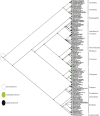A review of inter- and intraspecific variation in the eutherian placenta
- PMID: 25602076
- PMCID: PMC4305173
- DOI: 10.1098/rstb.2014.0072
A review of inter- and intraspecific variation in the eutherian placenta
Abstract
The placenta is one of the most morphologically variable mammalian organs. Four major characteristics are typically discussed when comparing the placentas of different eutherian species: placental shape, maternal-fetal interdigitation, intimacy of the maternal-fetal interface and the pattern of maternal-fetal blood flow. Here, we describe the evolution of three of these features as well as other key aspects of eutherian placentation. In addition to interspecific anatomical variation, there is also variation in placental anatomy and function within a single species. Much of this intraspecific variation occurs in response to different environmental conditions such as altitude and poor maternal nutrition. Examinations of variation in the placenta from both intra- and interspecies perspectives elucidate different aspects of placental function and dysfunction at the maternal-fetal interface. Comparisons within species identify candidate mechanisms that are activated in response to environmental stressors ultimately contributing to the aetiology of obstetric syndromes such as pre-eclampsia. Comparisons above the species level identify the evolutionary lineages on which the potential for the development of obstetric syndromes emerged.
Keywords: adaptation; placenta; variation.
© 2015 The Author(s) Published by the Royal Society. All rights reserved.
Figures



References
-
- Benirschke K, Kaufmann P. 2000. Pathology of the human placenta, 4th edn New York, NY: Springer.
-
- Zamudio S, Palmer SK, Dahms TE, Berman JC, Young DA, Moore LG. 1995. Alterations in uteroplacental blood flow precede hypertension in preeclampsia at high altitude. J. Appl. Physiol. 79, 15–22. - PubMed
Publication types
MeSH terms
Grants and funding
LinkOut - more resources
Full Text Sources
Other Literature Sources
Medical
